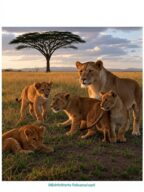
The Amur leopard also known as the Far Eastern leopard, is one of the rarest and most critically endangered big cats in the world. Native to the Primorye region of southeastern Russia and possibly parts of northern China, it is uniquely adapted to survive in the harsh, cold forests of the Russian Far East.
Physical Characteristics
Amur leopards are distinguished by their stunning coat, which features widely spaced rosettes with thick borders, providing excellent camouflage in their forested habitat. Their fur is thicker and paler in winter, turning a vibrant reddish-yellow in summer to blend with their surroundings. They are relatively small compared to other leopard subspecies, with males weighing 32–48 kg (70–106 lbs) and females 25–43 kg (55–95 lbs). Their long legs and muscular build make them agile climbers and sprinters, capable of speeds up to 37 mph (60 km/h).
Habitat and Range
Historically, Amur leopards roamed across the Russian Far East, northeastern China, and the Korean Peninsula. Today, their range is restricted to a small area along the Russia-China border, primarily in the Land of the Leopard National Park in Russia. They inhabit temperate, mixed forests with rugged terrain, enduring extreme winters with temperatures dropping below -30°C (-22°F). Their current habitat spans roughly 10,000 km², a fraction of their former range.
Behavior and Diet
Amur leopards are solitary, nocturnal hunters, relying on stealth and ambush to catch prey. Their diet includes sika deer, roe deer, wild boar, and smaller mammals like hares and badgers. They can drag prey three times their weight into trees to protect it from scavengers. These leopards are territorial, with males defending ranges up to 100 km², overlapping with smaller female territories. They communicate through vocalizations, scent marking, and claw scratches on trees.
Conservation Status
The Amur leopard is listed as Critically Endangered on the IUCN Red List, with an estimated 100–120 individuals left in the wild as of 2025. Major threats include:
- Habitat Loss: Deforestation, agriculture, and human development have fragmented their habitat.
- Poaching: Their beautiful fur and body parts are targeted for illegal trade.
- Prey Scarcity: Overhunting of deer and other prey species reduces their food supply.
- Inbreeding: Low population numbers lead to genetic issues, reducing reproductive success.
Conservation efforts have shown promise.
The Land of the Leopard National Park, established in 2012, protects over 60% of their habitat. Camera traps and monitoring programs track population growth, which has risen from a low of 30–35 individuals in the early 2000s. Reintroduction programs, like those at the Amur Leopard Reintroduction Center in Russia, aim to release captive-bred leopards into the wild. International cooperation between Russia and China has also created transboundary protected areas to support their survival.
Interesting Facts:
- Amur leopards are among the best jumpers of all big cats, capable of leaping 6 meters (20 feet) horizontally and 3 meters (10 feet) vertically.
- They can survive up to two weeks without food by relying on fat reserves.
- Each leopard’s rosette pattern is unique, like a human fingerprint, aiding in individual identification.
- They are one of the few big cats adapted to snowy environments, using their furry paws like natural snowshoes.
Challenges and Future
Despite conservation gains, the Amur leopard’s future remains precarious. Climate change, which alters prey availability and habitat conditions, poses a growing threat. Continued anti-poaching patrols, habitat restoration, and public awareness campaigns are critical to their survival. Organizations like the Amur Leopard and Tiger Alliance (ALTA) and WWF work tirelessly to ensure this elusive cat does not vanish.
The Amur leopard’s resilience in the face of adversity symbolizes the importance of global conservation efforts. Protecting this magnificent predator requires sustained commitment to preserving its habitat, securing prey populations, and fostering coexistence with local communities.

